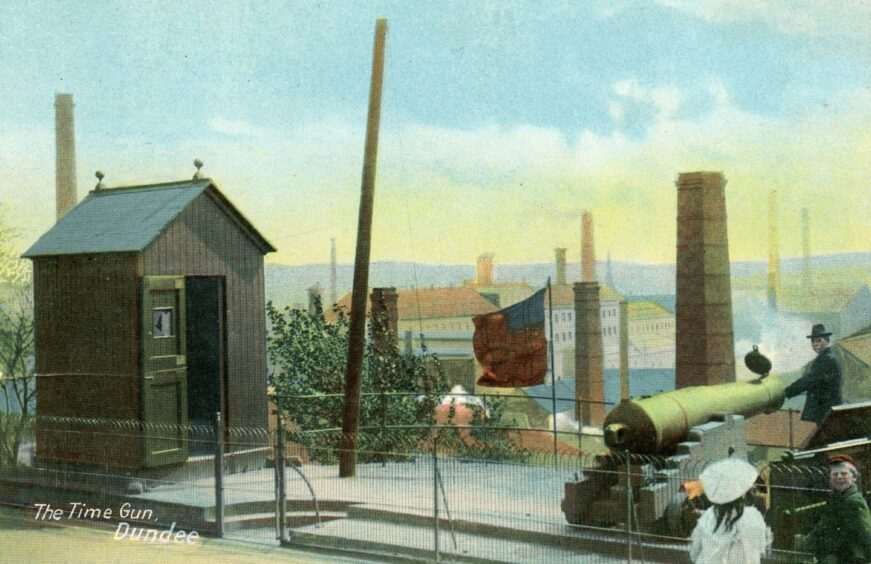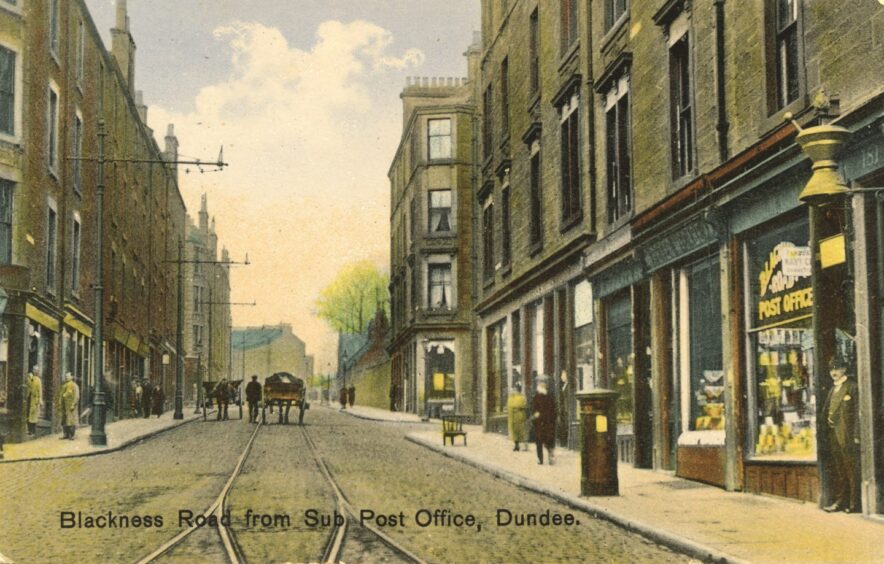
These historic postcards provide a fascinating glimpse of what Dundee was like during the early decades of the 20th Century.
They show Dundee and its buildings, streets and people.
This was the golden age of picture postcards.
Valentines of Dundee was the world’s largest producer of postcards and their closest Scottish rival, J. B. White, was also a local firm.
These images have become an invaluable archive for local historians.
Dundee was home of the picture postcard
Dundee: The Postcard Collection by Brian King dips into this archive and takes the reader on a stroll through many rare and fascinating images of the city.
Long-gone views are captured.
Brian said many old images only exist because they were captured for a postcard.
“There are postcards in the book showing places like Americanmuir Road, Peddie Street or Tipperary in Lochee, which would probably not have been visited by photographers had it not been for the postcard,” he said.
“Other postcards reflect important national or local events such as the Tay Bridge disaster, the fire at Watson’s Bond and the First World War.
“Many postcards also depict streets such as the old Wellgate or buildings like the Town House that long have since been demolished.”
Take a trip back in time with these Dundee postcards.
Reform Street
Brian said: “Named after the Great Reform Act of 1832, which increased the franchise for parliamentary elections, Reform Street was laid out by the Perthshire-born architect George Angus.
“It provided a new route from the High Street to the town’s meadows and the High School of Dundee, which was also designed by Angus.
“The familiar pairing of Boots the chemist and the jeweller H. Samuel lasted over 100 years until Samuel’s was replaced by another jeweller, Chisholm Hunter, in 2020.”
High Street
Brian said: “The Town House was designed by Fife-born architect William Adam as the seat of local government and dominated Dundee’s High Street for almost 200 years until its demolition in 1932.
“The council and Guildry chambers were on the first floor.
“The town’s jail was on the floor above.
“Known locally as The Pillars, the colonnade of the Town House was a popular meeting place and contained several shops including the original Braithwaite’s coffee shop.”
Murraygate
The Murraygate has long been one of Dundee’s most important streets.
While many instinctively believe that the street runs from east to west, it, in fact, runs pretty much north to south,” said Brian.
“The tramlines were retained here after the trams stopped running in 1956.
“The street became the first in Dundee city centre to be pedestrianised.”
D.M. Brown
Brown’s was one of Dundee’s best known department stores.
Brian said: “In 1888, its founder, David Millar Brown, established his own business in Dundee’s High Street, gradually expanding until he had established one of the city’s largest department stores, which employed more than 500.
“It also had a high-class restaurant known as the Pillared Room, which is depicted above.”
Dundee Time Gun
Dundee’s time gun was inaugurated on September 3 1872 at Dudhope Castle.
It was fired daily at one o’clock as a signal to shipping.
Brian said it operated until 1916 when it was discontinued largely due to complaints about its effect on shell-shocked soldiers who were patients in the nearby infirmary.
The gun was used to mark both Armistice Day and New Year until 1936.
Blackness Road
Brian said: “Blackness Road itself takes its name from the estate of the same name, which once occupied the area.
“The estate, in turn, takes its name from the Black Ness, a rocky headland which, before it was swallowed up by land reclamation, once protruded into the River Tay at a point near where the rail bridge meets the land at Riverside Drive today.”
Logie Estate
The Logie estate put Dundee on the housing map at home and abroad in 1920.
Brian said: “It was designed by the city architect James Thomson and was laid out as a garden suburb with the streets curved off a central boulevard.
“Logie set standards that few later public housing schemes could match.
“The scheme is now a conservation area.”
Dundee Law
The postcard of Dundee Law can be dated to the early 20th Century.
The photograph was taken before the war memorial was opened in May 1925.
Brian said: “Further construction, the erection of a communications mast and the reintroduction of trees to the hill mean that the Law looks particularly bare when compared to its 21st Century appearance.”
Lochee
A tram heading up Lochee High Street.
“Lochee, which became part of Dundee in 1859, is thought to have originated in an area near what is now South Road in the vicinity of Myrekirk,” said Brian.
“The population of the village greatly expanded in the 19th Century when the Cox family moved their textile business to a new site at Harefield and shifted the focus of the village to the area around the present High Street.
“At its peak, Camperdown Works employed around 5,000 people.”
Hilltown
The Hilltown was once a separate barony outside the Burgh of Dundee.
It was also known Rotten Row.
Brian said: “The colour postcard looks down the hill and shows the steep incline that meant that horses sometimes struggled to pull their carts uphill and that trams did not operate at all in this area.
“In the distance, the Wellgate completes the descent to the city centre.”
Broughty Ferry Esplanade
Brian said: “Broughty Ferry’s esplanade was completed in 1894.
“Such esplanades were popular in the late Victorian and Edwardian periods.
“It also meant that the better-dressed walker did not even have to venture on to the sand and risk damaging their clothes.”
How did Brian gather postcards of the city?
Postcards had first been issued in the UK by the Post Office in 1870 as a simple means of sending a short message rather than a formal letter.
In 1897 the government granted permission to write or print on the reverse side of a postcard and Valentines was quick to take advantage of this concession.
A new industry was being born.
Brian said: “I have been collecting old postcards of Dundee for a while now.
“Many of them were bought at antique and collectors’ fairs but, of course, it is possible now to pick them up online as well.
“Postcards are rapidly becoming a thing of the past in a world where people can send instant messages, pictures and video but for much of the 20th Century they were a cheap means of keeping in touch.
“They were meant to be disposable but many of the images that were captured now have historic importance.
“This book brings together and preserves for the future a collection of these fascinating images of Dundee.”
- Dundee: The Postcard Collection by Brian King is on sale now.
























Conversation